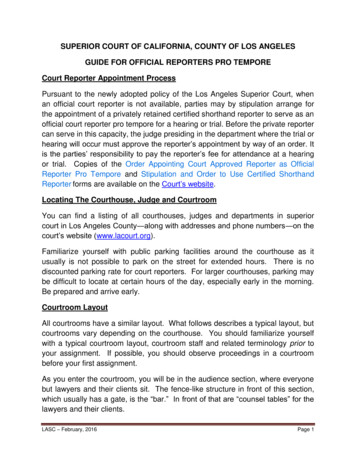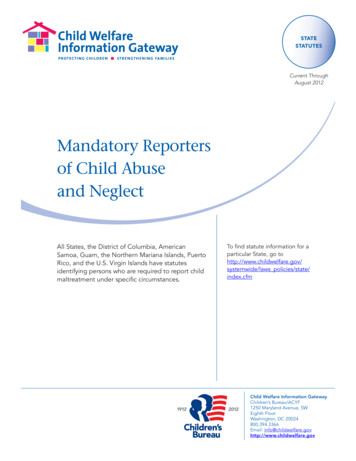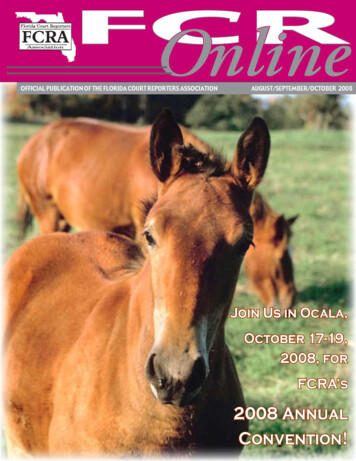
Transcription
SUPERIOR COURT OF CALIFORNIA, COUNTY OF LOS ANGELESGUIDE FOR OFFICIAL REPORTERS PRO TEMPORECourt Reporter Appointment ProcessPursuant to the newly adopted policy of the Los Angeles Superior Court, whenan official court reporter is not available, parties may by stipulation arrange forthe appointment of a privately retained certified shorthand reporter to serve as anofficial court reporter pro tempore for a hearing or trial. Before the private reportercan serve in this capacity, the judge presiding in the department where the trial orhearing will occur must approve the reporter’s appointment by way of an order. Itis the parties’ responsibility to pay the reporter’s fee for attendance at a hearingor trial. Copies of the Order Appointing Court Approved Reporter as OfficialReporter Pro Tempore and Stipulation and Order to Use Certified ShorthandReporter forms are available on the Court’s website.Locating The Courthouse, Judge and CourtroomYou can find a listing of all courthouses, judges and departments in superiorcourt in Los Angeles County―along with addresses and phone numbers―on thecourt’s website (www.lacourt.org).Familiarize yourself with public parking facilities around the courthouse as itusually is not possible to park on the street for extended hours. There is nodiscounted parking rate for court reporters. For larger courthouses, parking maybe difficult to locate at certain hours of the day, especially early in the morning.Be prepared and arrive early.Courtroom LayoutAll courtrooms have a similar layout. What follows describes a typical layout, butcourtrooms vary depending on the courthouse. You should familiarize yourselfwith a typical courtroom layout, courtroom staff and related terminology prior toyour assignment. If possible, you should observe proceedings in a courtroombefore your first assignment.As you enter the courtroom, you will be in the audience section, where everyonebut lawyers and their clients sit. The fence-like structure in front of this section,which usually has a gate, is the “bar.” In front of that are “counsel tables” for thelawyers and their clients.LASC – February, 2016Page 1
The judge usually sits behind a raised desk opposite the entrance to thecourtroom; this is the “bench.” The area between the bench and counsel tables iscalled the “well.” The judge’s private office is called his or her “chambers.” Youshould not enter the judge’s chambers or the well unless you have thepermission of the judge or courtroom staff.The jurors sit in the “jury box,” which is the separate section of 12 seats on theright or left wall. The jury room is through a door next to the jury box. That iswhere jurors deliberate, and often they are asked to go there when the judge ishandling matters outside the jury’s presence (see below).Witnesses testify from the “witness stand,” which will be on the side of the benchnearest the jury box. Court Reporter work stations are usually in front of thewitness stand.The judicial assistant’s (clerk) desk is usually situated perpendicular to thejudge’s bench, on the side opposite the jury box. The clerk is generallyresponsible for the clerical part of the court’s work. The clerk is familiar with thejudge’s practices and preferences and can be an invaluable source of informationfor you.The bailiff or courtroom assistant is usually seated next to the bar on the sameside of the courtroom as the clerk. The courtroom assistant/bailiff is responsiblefor keeping order and security in the courtroom and for taking care of the jurorsor potential jurors.At counsel table, the plaintiff’s lawyer is usually on the side closest to the jury boxand the defendant’s lawyer is on the other side. These tables are usuallylabeled.Getting To The Courtroom (On Time)It is essential that you be on time. Court proceedings cannot begin without areporter. In the unlikely event that you must be late, you must inform theattorneys who have hired you and, only when that is not possible, the clerk of thecourt. Make sure you have, at hand, the phone number for the courtroom towhich you have been assigned.It is advisable that you arrive at the courthouse at least 30 minutes in advance ofyour scheduled appointment. You will need extra time to go through security atthe entrance of the courthouse. You must have your CSR pocket certificate withLASC – February, 2016Page 2
you and be prepared to show it if requested. You will need to pass yourequipment through the security machines. At the larger courthouses, it may atake a long time to go through security, especially early in the morning. At somecourthouses, you also need to allot extra time to use elevators to get to yourfloor.Also, you need to arrive early to set up your equipment and to check in with thejudge and courtroom staff (discussed below). If the courtroom door is lockedwhen you get there, knock on the door and introduce yourself as the courtreporter and ask to be let in so that you can set up.Checking InIn addition to setting up your equipment, there are a number of things you shoulddo before the commencement of the proceedings: When you get to the courtroom to which you have been assigned,introduce yourself to the clerk and courtroom assistant or bailiff. Give theclerk your business card with your CSR number on it. If possible, introduce yourself to the judge before the commencement ofproceedings. Ask the judge or clerk of if there are any special procedures or practices ofwhich you should be aware. Make sure you know the following at aminimum: (1) how the judge handles sidebars or bench conferences(discussed below) and how you should know whether to report them; and(2) how the judge prefers that you stop proceedings when you cannotfollow or understand the witness or attorneys. If you are reporting a law and motion matter, look at the calendar that isposted outside the courtroom door to see when your case will be heard.The judge, however, may change, at any time, the order in which thecases will be heard; thus, you need to stay in the courtroom. There couldbe several court reporters there to report other matters. Ask the clerkwhere you should wait in the courtroom until your turn comes up. If for anyreason you leave the courtroom, you should inform the attorney(s) whohired you of your whereabouts.LASC – February, 2016Page 3
All attorneys addressing the court are supposed to first check in with theclerk or courtroom assistant and provide their business cards or contactinformation. Make sure that you have this information before theproceedings commence so that you may correctly identify the attorneys inyour notes. If multiple attorneys are seated at a table, it is possible that allwill speak in the course of the proceedings. Clerks/courtroom assistantsoften get extra business cards for the reporter; if this isn’t their practice,ask the lawyers directly. Give your business card to the lawyers appearing on your case. Read and sign the Order Appointing Court Approved Reporter as OfficialReporter Pro Tempore or Stipulation and Order to use Certified ShorthandReporter form as required.Courtroom ScheduleCourtroom hours are usually from 8:00 a.m. to 5:00 p.m. The court will take anumber of breaks during the day and will close for lunch. You normally cannotstay in the courtroom during the lunch break.Courtroom Etiquette And ProtocolYou must dress professionally in businesslike attire suitable for the courtroomenvironment—shirt and tie, slacks, dress, blouse, skirt, sweater, business suitattire.No food or drink should be consumed in the courtroom. Some judges make anexception for water.No cell phone use is permitted in the courtroom. Make sure that you turn off yourcell phone or put it on silent mode.You should not tell anyone to contact the court in order to reach you or to leaveyou a message.Always address the judge as “Your Honor” or “Judge [last name],” unless he orshe indicates otherwise.LASC – February, 2016Page 4
(No) Contact with JurorsYou should minimize contact with jurors or potential jurors, while remaining politeand cordial. If a juror or potential juror insists on having substantive contact orconversation with you, beyond routine greetings, report the situation to thecourtroom assistant or court clerk. When having conversations in or outside ofthe courtroom (including in public restrooms, courtroom hallways and cafeteria),remember that you may be in the earshot of a juror or potential juror and that youshould not discuss any matter related to the case before the court—neither thesubstance of the case nor anything about the parties or lawyers.Although you are not an employee of the court, the jurors or potential jurors viewyou as an official of the court. It is imperative that you not act in a way that maycreate the appearance that you favor one party over the other, or one party’sattorney over the other party’s attorney. You must appear to be impartial at alltimes.Opening of Trial Court ProceedingsThere are two ways in which trial court proceedings are commenced dependingon the circumstances and the judge’s preference.A formal opening is usually done at the beginning of trial when the judge entersthe courtroom and the jurors are present. The courtroom clerk will ask all to rise(including the reporter) and face the flag. You do not need to report this.An informal opening is when the judge enters the courtroom and everyoneremains seated. This is usually done when jurors are not present.In either case, either the clerk or the courtroom assistant will announce what ishappening.Hearings on MotionsYou may be appointed to report a hearing on a motion.There are many types of motions. A motion is basically a procedural device usedby counsel to bring an issue in front of the judge. Motions are set for hearingonce the parties have had a chance to file papers in support of or in opposition tothe motion. The judge may rule on a motion from the bench immediately aftercounsel’s arguments or may issue a written ruling sometime after the hearing.LASC – February, 2016Page 5
You should report all the statements made by the judge or counsel during ahearing.Stages of TrialThere are two types of trials—court trials and jury trials. Some trials are“bifurcated” so that some issues are tried to the court and others to the jury.In a court trial, there is no jury; the judge decides everything. In a jury trial, thejury decides the facts, while the judge makes legal decisions.Trial usually commences with counsel arguing motions in limine―parties bringthese motions when they want to prevent their opponents from presenting certainevidence at trial. Then come opening statements by counsel. The plaintiffpresents his or her case first through witness testimony and presentation ofevidence. For each witness, there will be direct examination, cross-examination,redirect examination, and recross-examination until questioning is complete. Atthe close of the plaintiff’s case, defense may make motions upon which the courtwill rule including a motion to dismiss. If the judge does not dismiss the case, thedefendant presents his or her case in the same manner as the plaintiff. Counselwill make their closing arguments, and then the judge or the jury will decide thecase.If you are there for a jury trial, the following steps are added to the foregoingproceedings. Before the case commences, a jury is selected through a processcalled “jury voir dire.” At different junctures in the case, the judge will readinstructions to the jury. After counsel present closing arguments, the jury willstart deliberating the case. There is no way to predict how long jury deliberationswill take. It may take a few hours or span over a number of days. While the juryis deliberating, your services may be required to read back testimony to the jury,or to report questions posed by the jury or issues that arise with the jury. Oncethe jury reaches a verdict or is unable to reach a verdict (this is called a “hungjury”), you will return to court to report the result.LASC – February, 2016Page 6
Reporting of Trial ProceedingsWith the exception of testimony presented by audio or video recording (seebelow), unless you are told otherwise you must report everything that happensfrom the beginning of the trial until the end. Look to the judge for guidance; onlythe judge can tell you whether to go off the record. If you are unsure, ask. It isbetter to report something that does not need to be reported than to fail to reportsomething that is necessary. Jury Voir DireJury voir dire is the process by which jurors are selected to serve in a trial.Potential jurors are questioned as a group or individually by the judge and/orcounsel.You normally will be required to report jury voir dire, but getconfirmation from the judge beforehand.Obtain a copy of the Jury Case Information Sheet (prospective juror list) from theJudicial Assistant prior to commencement of jury voir dire (both the Random andAlphabetical lists). Verify with the clerk or courtroom assistant where juror #1 willbe seated and the order of seat assignments. The lists contain the prospectivejurors’ names and the juror identification (JID) numbers. Keep the jury lists in asecured place as they contain confidential information. Bench And Chambers ConferencesA “bench conference” is basically a conversation between the judge and counseloutside the presence of the jury. They are generally held at “side-bar”—counselapproach the bench and speak with the judge in close proximity with soft voices,so the jury can’t hear anything they say. A “chambers conference” is anotherprivate conversation between the judge and counsel, but held in chambers.Before trial commences, ask the judge or court clerk about how the judgeconducts these conferences.Not all bench and chambers conferences need to be reported. You will need totake instruction from the judge whether to report a conference. If in doubtwhether you should report, ask the judge.You are responsible for bringing with you whatever special equipment you mayneed to report bench conferences. Many court reporters have their own pocketsized microphone/amplifier with a headset so they may stay seated andconnected to their laptop while the judge and counsel conduct a benchLASC – February, 2016Page 7
conference. The headset will require an extra-long headset cord. Someelectronics stores carry this equipment.If your computer screen will be within any juror’s sight during a benchconference, be sure to toggle your screen off while the conference is takingplace. In Camera Proceedings“In camera” literally means “in chambers,” but it’s different from a chambersconference. A legal proceeding is “in camera” when the public, jury andsometimes even a party and his/her counsel are excluded from the proceedings.In camera proceedings may involve disclosure of sensitive, confidential orattorney-client privileged information. Depending on the judge’s practice, theseproceedings take place in the courtroom (once it has been emptied of allindividuals who are not entitled to participate in the proceedings) or in chambers.You may be required to report these proceedings, but you need to be careful towhom you may release a transcript of these proceedings. If you are not clear onwho is entitled to have access to a transcript of these proceedings, ask the judge. Sealed ProceedingsSometimes, the judge will order that certain proceedings be sealed. In such acircumstance, the reporter’s notes may only be transcribed with a Court order,and the reporter is required to segregate that portion of his/her notes. Judge’s Reading of Jury InstructionsThe judge reads instructions to the jury at two junctures in the course of a trial:(1) at the commencement of the case once a jury has been impaneled, beforeany evidence is presented and before counsel’s opening statements; and (2)after all evidence is presented, and either before or after counsel’s closingarguments and before the jury commences its deliberations.You normally will report the judge’s reading of the jury instructions, but youshould get confirmation from the judge. Swearing of WitnessThe judge or clerk administers the oath to the witness―not you. The swearing ofthe witness is reported verbatim and is included in the transcript.LASC – February, 2016Page 8
Deposition Readings/Video DepositionsAt trial, counsel will at times read testimony from deposition transcripts. Youmust report verbatim what the counsel reads from the deposition transcript.Video or audio recordings are subject to California Rules of Court rule 2.1040,under which ordinarily you do not report what is said in the recording. Check withthe judge to be sure whether he or she expects you to report that part of the trial. Attorney ObjectionsCounsel will voice objections for various reasons throughout the trial courtproceedings, including during witness testimony. The judge usually immediatelyrules on each objection from the bench. You must report all objections beingmade by counsel and the judge’s ruling on the objections. If you are havingdifficulty reporting because multiple people are speaking at the same time, youshould stop the proceedings and inform the judge.Court Reporter Read-Back During TrialDuring trial, you will take direction from the judge whether to read back aquestion or answer. During Jury DeliberationsOnce the jury commences its deliberations, it may request to have a read-back oftestimony. You may need to make yourself available on very short notice forreading back to the jury. The judge will determine whether you should read backto the jury in open court or in the jury room. Counsel may or may not be presentduring read-back. You may read back testimony from a printed transcript, yourcomputer or your notes.While in the jury room, you should not talk with the jurors or offer your opinions.You are there only to read back testimony. The jurors should not be deliberatingwhile you are in the jury room. It is permissible for the jury to ask that you repeatyour read-back.Make sure that you make note of the testimony you read to the jury for thepurposes of appeal.LASC – February, 2016Page 9
When reading back testimony, abide by the following: Do not read any testimony that was strickenDo not read questions or answers to which objections were sustainedDo not read overruled objectionsRead only testimony or stipulations presented to the jury; do not read anyportion of a bench or chambers conference or of an in camera proceedingIf more than one reporter worked on the case, all reporters must be available fora read-back or, alternatively, one reporter can read back if the testimony hasalready been edited for correctness by the reporter who reported the proceeding.Reporting Equipment and SuppliesYou are responsible for bringing with you all the equipment and supplies that youwill need to perform your work. The court does not provide any steno paper orother court reporter supplies and will not have any copying equipment availableto Reporters Pro Tempore.You may leave your equipment in the courtroom during breaks and lunch recess.You should not leave your equipment in the courtroom overnight. Janitorial staffcleans the courtroom nightly and the court is not responsible for court reporterequipment left overnight.Trial Exhibits: Identification and Admission Into EvidenceUnlike in depositions, in which exhibits are only identified, at trial two distinctthings can happen with exhibits: They are identified, and then—assuming thejudge has not sustained an objection—they may be admitted into evidence. Youmust note both occurrences in the body of the transcript. The rules of courtrequire that they both be included in the index in the record on appeal.The clerk, not you, is responsible for handling and labeling the trial exhibits.Transcripts Generated in The Course of Trial or After A HearingCounsel may request reporter’s transcripts immediately after a hearing on amotion or in the course of trial. Depending on the purpose for which thetranscripts will be used, counsel may request non-edited daily transcripts or finaledited transcripts. Final transcripts should contain 28 lines per page.LASC – February, 2016Page 10
Pursuant to California Code of Regulations, Professional Standards of Practice2475, you are required to promptly notify―when reasonably possible― all knownparties or their attorneys who were in attendance at a civil court proceeding of arequest for preparation of all or any part of a transcript, including a rough draft, inelectronic or paper form.Real Time TranscriptionThe parties may require that you provide real time reporting. The court providesjudges with LiveNote software on all judicial officer PCs. You do not have accessto wireless connections in the courtroom but there should be a 9-pin serial portcable available in each courtroom to allow you to connect your equipment withthe judge’s computer. For more detailed information regarding real timeconfiguration in the courtroom, check the Court Reporter Realtime SoftwareRequirement.Depositing Notes Or Electronic Copy of Notes With the CourtYou must leave an electronic copy of your raw notes with the Court as directedby the Court’s Director of Courtroom Support. Government Code §69955provides that reporting notes are “official records of the court,” and must be keptby the reporter in a place designated by the court, or, if ordered by the court,delivered to the clerk.LASC requires you deliver a copy of the raw stenographic notes generated byyour machine during reporting to the Court Reporter Services Office within 48hours of the conclusion of the proceedings for which you were contracted. Youmay do so either by mail or via e-mail. Please label them with the following: NameCSR numberDate(s) of proceedingNumber of filesType of stenographic machine and CAT software usedCurrent telephone number andE-mail addressLASC – February, 2016Page 11
Mail delivery:Court Reporter Services OfficeMetropolitan Courthouse1945 South Hill Street, Room 801-ALos Angeles, CA 90007Attn: ACORNE-mail delivery: courtreporterservices@lacourt.org and attach the raw stenographic notefile(s); The subject line must reference ACORN, and Your email must include your name, CSR number, date of the proceedingsof the attached file(s), number of files transmitted, type of stenographicmachine and software used, and telephone number.If you have any questions regarding this requirement, or you have paper noteswith no electronic copy available, please contact the Court Reporter ServicesOffice at (213) 745-3183.LASC – February, 2016Page 12
SUPERIOR COURT OF CALIFORNIA, COUNTY OF LOS ANGELES GUIDE FOR OFFICIAL REPORTERS PRO TEMPORE Court Reporter Appointment Process Pursuant to the newly adopted policy of the Los Angeles Superior Court, when . court in Los Angeles County―along with addresses and phone numbers―on the court's website (www.lacourt.org). .










